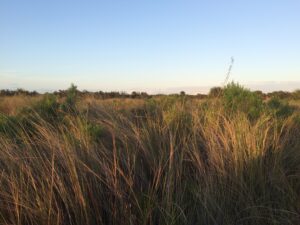
Fire can be a valuable tool to manage the distribution and composition of vegetation and reopen habitats for Black Rails. Susan McRae
Black Rail Management Guidance Document Released
The Black Rail Conservation Plan indicates the urgent need to focus habitat work in non-tidal locations where birds are relatively safe from regular flooding events. This effort requires that the conservation community quickly create a network of high-quality Black Rail habitat throughout their current range. However, one of the many challenges of conserving Black Rails is how little we know about how to create appropriate habitat for them. In an effort to assist practitioners in this journey, the Center for Conservation Biology and the Black Rail Working Group (through funding from NRCS) have released the Eastern Black Rail Management Guidance document. This document is the first of its kind to compile the breadth of information we know about Black Rail habitat requirements, management endpoints and strategies, priority opportunity areas and conservation approaches. Although we cannot yet prescribe specific management actions for individual properties, the management endpoints and context contained within the report provide a target to shoot for. Customized designs can then be created to achieve those endpoints in the context of the unique landscapes in which our partners work. This will be a living document that will be updated regularly to reflect expertise gained as more and more projects are implemented and evaluated on the ground.
Black Rail Adaptive Management Project
The ACJV and USGS are engaged in a multi-year collaborative project to develop an adaptive management framework to evaluate several hypotheses regarding management of habitat for Black Rails. We hit several milestones in the effort this year. We hosted several expert informational sessions and workshops to develop, refine, and finalize the conceptual models that will inform the analytical model structure. We also recreated these conceptual models in software that can easily be used in analyses of data once projects begin. In 2023 we hope to create and finalize the database for this project that can house data collected by projects operating within this analytical framework. Ultimately, this project will improve our understanding of how to implement priority management actions for this species.

Inland non-tidal Black Rail habitat at St. Johns National Wildlife Refuge, Brevard County, FL. Adam Smith
Identifying Potential Sites for Habitat Creation
In 2021, the ACJV developed a spatial layer based on occupancy predictions for eastern Back Rail (Stevens and Conway 2022) to identify priority areas to target habitat creation for Eastern Black Rails. This layer outlines lands suitable for management within 30km of potentially occupied tidal marsh habitat – the radius within which rails are most likely to recruit from occupied sites. In 2022, we identified additional priority areas by creating a 30-km buffer around recent Black Rail occurrence data in non-tidal areas in Florida (Florida Wildlife Commission, unpublished data). These layers can be used to identify opportunities for wetland creation projects on the ground and can be found here: BLRA potential habitat tool.

